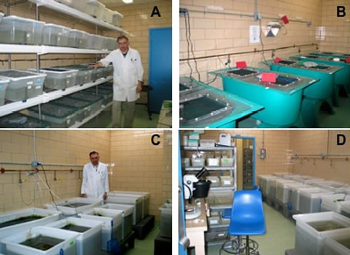Vivarium

Split-view of the vivarium's features.
Our animal resource facility include four newly renovated rooms in the vivarium that are designated for maintaining experimentally manipulated amphibians and for maintaining and breeding stocks of outbred, partially inbred, and cloned lines of Xenopus. Rooms are controlled for light cycle and temperature and have filtered and declorinated water "on tap". Room one (A) houses two four-tier racks; each rack holds holding 24 aquariums (each measuring 23" x 15" x 8.5" (length x width x depth)). A temperature-controlled continuous flow water system supplies temperature-adjusted water drip-wise, via a stopcock, to each of these aquariums. The flow system is equipped with thermal sensors that automatically shut off the flow of water if the temperature deviates from preset values. Room two (B) houses 10 50-gallon aquariums; a photo of some of these large aquariums is shown below. Room three houses mouse cage racks with standard shoebox "cages" for keeping individual or small numbers of frogs. Room four (C, D) is mainly devoted in rising larvae in large tanks. A small area with a table and stereomicroscope in this will allow the selection of diploid eggs after gynogenesis, and minor animal surgery. A satellite facility, outside the main vivarium, is devoted to studying an emerging infectious disease caused by ranaviruses (Iridoviridae). This facility can house up to 500 animals in containment.
All animal facilities and programs are responsible to the vivarium and Division of Laboratory Animal Medicine of the School of Medicine and Dentistry and are fully accredited by the American Association for Accreditation of Laboratory Animal Care and in compliance with state law, federal statute and Federal Policy.